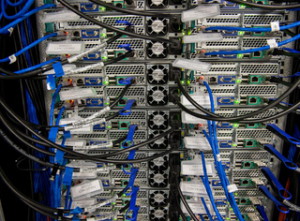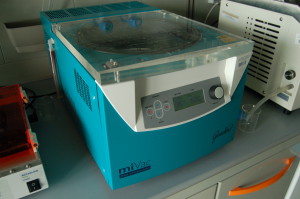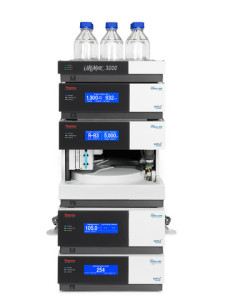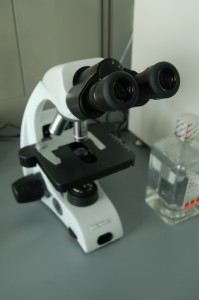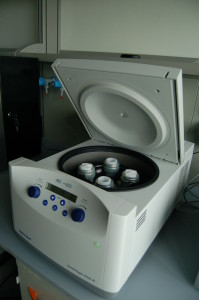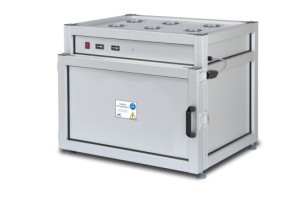Molecular Modeling:
Computer cluster
Computer cluster will consist of a number of multi-core Xeon processors; every node will possess at least 128 GB RAM and the whole system will be equipped with disk array of ca 30 TB. InifiniBand (56 GB/s) will be employed for networking communications. The following software will be installed on the cluster: Gaussian 09 with LINDA for its DMP-type parallel execution, cp2k, Amber, FDynamo as well as the PBS queueing system. The purchase will be supported by the NSC funds obtained via the MEASTRO 6 funding scheme (2015).
Chemical Synthesis:
Freeze dryer and DNA concentrator
Equipment (ALPHA 1-2 LD Plus (Martin Chris); miVac (Genevac)) used for concentrating samples, removing water and organic solvents. Both devices allow for the control of pressure, temperature and time during the drying process. The purchase supported by the Polish Ministry of Science and Higher Education (MNiSW) via the individual project funding scheme (call no 40).
Rotary evaporator with vacuum membrane pump
This rotary evaporator (Hei-VAP (Heidolph)) is used at a number of stages of chemical synthesis e.g. for distillation, solvents removal and samples concentration. It conforms to leading safety standards and features an ease and quick use. The purchase was supported by the NSC funds obtained via the PRELUDIUM 4 funding scheme (2013).
Preparative HPLC System
Preparative HPLC system, which allows for purification and identification of synthesized compounds. This system will be equipped with a fraction collector, both manual and automatic injection valve with sample loop and UV-VIS diode array detector. A very useful feature of this HPLC system will be a possibility to use a wide range of flow rates and chromatographic columns of different diameters and lengths. The purchase will be supported by the NSC funds obtained via the MEASTRO 6 funding scheme (2016).
Enzymatic Synthesis and Photochemical and Radiolytic Studies:
Mass Spectrophotometer
The high-resolution LC-MS system (TT5600+ (SCIEX)) is used to identify chemical compounds and determine their structures (is suitable for small and large molecules). In this equipment, the micro LC system is coupled directly to a QTRAP quadrupole time-of-flight (QTOF) mass spectrometer (AB SCIEX) equipped with the duo-electrospray interface. The purchase supported by the Polish Ministry of Science and Higher Education (MNiSW) via Funds for Science and Polish Technology (2013).
PCR Thermocycler
This PCR device (Mastercycler gradient, Eppendorf) is equipped with a gradient function which simplifies protocol optimization. A programmable gradient function enables a temperature gradient within 20°C to be generated at all steps of the PCR reaction. The purchase supported by the Polish Ministry of Science and Higher Education (MNiSW) via the individual project funding scheme (call no 35, 2008).
Real-time PCR system
This device (Biorad CFX96) is used in quantitative, real-time PCR. With fluorescence probes selectively binding to specific sequences in DNA, this advanced, rapid and sensitive analytical tool enables the integrity of the labelled region of the biopolymer to be determined quantitatively. This method is dedicated to studies on damaged DNA but also allows determining how genetic expression of particular genes change over a time in the response of a cell culture to chemical agents, as well as changes in environment, including the action of UV and γ-radiation. The purchase supported by the NSC funds obtained via the OPUS 3 funding scheme (2013).
Gel visualization/documentation system
The highly sensitive system (Fusion FX Fishert Biotec) with a broad spectrum of features including high-resolution camera with motorised fixed focal length lens with autofocus, motorised filter wheel and darkroom with built-in UV/LED transilluminator. The purchase supported by the Polish Ministry of Science and Higher Education (MNiSW) via Funds for Science and Polish Technology (2013).
UV irradiation setup
This optical system is used for the steady – state photolysis of studied samples. A light source is the high-pressure mercury/xenon lamp. The specified wavelength of incident light is selected using a grating monochromator (M250, Optel). The system is also equipped with an electronic UV-meter, enabling precise determination of radiation dose. The purchase supported by the NSC funds obtained via the OPUS 3 funding scheme (2013).
HPLC systems
Two modular systems for high performance liquid chromatography (Dionex UltiMate 3000 System and LC-10AS, Shimadzu), used as one of the basic research tool, both in quantitative and qualitative analysis of photo- and radiation-induced DNA damage. One of the chromatographs is equipped with autosampler and UV-VIS photodiode array detector. The purchase supported by the Polish Ministry of Science and Higher Education (MNiSW) via the individual project funding scheme (call no 40).
UHPLC system
The modular UHPLC delivers important benefits – faster runs, better resolution, and lower operating costs. This system will be equipped with three types of detectors: UV-VIS photodiode array detector, fluorescence detector and a universal, mass-based, evaporative light scattering detector (ELSD), which can detect a wide range of products, even those without any chromophore. This configuration of UHPLC system enables to achieve high sensitivity, accuracy and effectiveness of analysis. The purchase will be supported by the NSC funds obtained via the MEASTRO 6 funding scheme (2016).
Cell-based Studies:
Laminar flow hood
Special laboratory equipment (Biosan UVC/T-B-AR) used to create a working space free of pollution. Cell culture in vitro requires primarily sterile conditions. The use of the chamber with laminar air flow guarantees a sterile conditions during the operations with the cells. The purchase supported by the NSC funds obtained via the PRELUDIUM 4 funding scheme (2013).
CO2 incubator
This equipment (Binder C 150) provides appropriate conditions for cells growth: optimal temperature and humidity and appropriate levels of CO2. The optimum humidity in growth environment for the majority of human tumor cells should be maintained at 95%, and optimal CO2 concentration (5 – 10%) in an incubator for cell culture is very important to ensure the proper pH of the cell culture medium. The purchase supported by the NSC funds obtained via the PRELUDIUM 4 funding scheme (2013).
Microscope
This optical device (OPTICA B-353PL ) is used for the cell counting in in vitro cell culturing. The cell concentration needs to be known in order to adjust accordingly the amount of reagents and chemicals that are to be applied in the experiments. The purchase supported by the NSC funds obtained via the PRELUDIUM funding scheme (2013).
Refrigerated centrifuge
This centrifuge (5702 R, Eppendorf) is needed during many operations in cell culture lab; for example to perform the isolation and purification of genomic DNA or thawing frozen cells. The temperature control provides high reproducibility. The purchase supported by the NSC funds obtained via the MEASTRO 6 funding scheme (2015).
Multimode Plate Reader
The high-quality reader (EnSpire, Perkin Elmer) possessing different modes of detection: absorbance UV-VIS and fluorescence (including time resolved fluorescence). Used during many cellular assays. Its great advantage is the possibility of any wavelength selection. The purchase supported by the Polish Ministry of Science and Higher Education (MNiSW) via Funds for Science and Polish Technology (2013).
X-ray biological irradiator
This is a dedicated, compact cabinet x-ray cell irradiator which can be placed directly on the lab bench top. This is smaller, simpler and safer alternative to radioisotope (gamma) and high-power x-ray irradiators. This system allows irradiating cells and other samples in a lab without compromising sterility or security. The system is equipped with the integrated dosimeter with advanced Automatic Dose Control (ADC) for setting exact dose. The purchase will be supported by the NSC funds obtained via the MEASTRO 6 funding scheme (2016).
UV-VIS irradiation chamber
UV irradiation chamber is a robust equipment for the time- or dose-controlled irradiation of samples, including cell cultures, with UV or visible light. The chamber can be fully equipped for one of the spectral regions UV-C, UV-B, UV-A or visible light. The system possesses an irradiation control that can separately control two different spectral ranges and obtain a constant dose regardless of the lamp ageing or temperature. The purchase will be supported by the NSC funds obtained via the MEASTRO 6 funding scheme (2016).
Flow cytometer
The flow cytometer will be used in a number of cell-based assays, such as viability tests, cell cycle analysis, cell proliferation assay or analysis of DNA damage. The device is equipped with several lasers and fluorescent detectors, which enables the analysis of various fluorochromes and ensures high precision of both quantitative and qualitative analysis. The purchase will be supported by the NSC funds obtained via the MEASTRO 6 funding scheme (2016).
Inverted fluorescence microscope
An inverted fluorescence microscope will be applied in a number of cell-based studies. The planned model stands out for high-quality optics which provides high-contrast and high- resolution imaging. In addition, the microscope will be equipped with a special system allowing for intracellular measurement of oxygen concentration. The purchase will be supported by the NSC funds obtained via the MEASTRO 6 funding scheme (2016).
CO2/O2 Incubator
An incubator with O2 concentration control provides excellent growth conditions for mammalian cell cultures and precise control of oxygen concentrations. Hypoxia is a characteristic phenomenon for most solid tumors and hypoxia research requires stabile and reproducible O2 levels. The purchase will be supported by the NSC funds obtained via the MEASTRO 6 funding scheme (2016).
